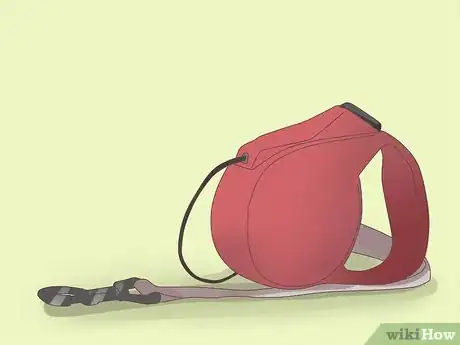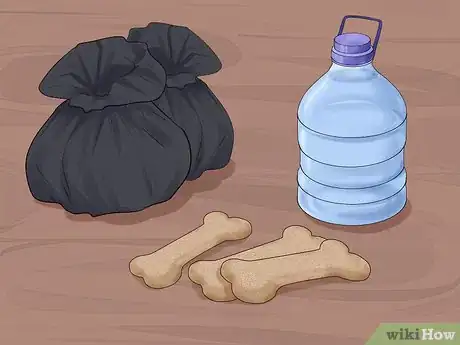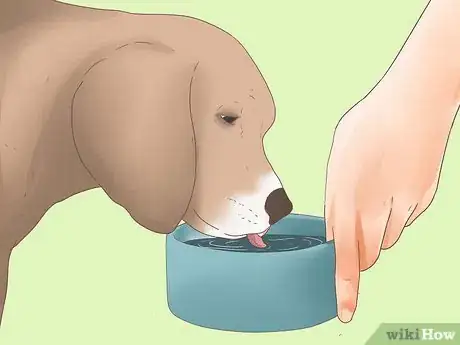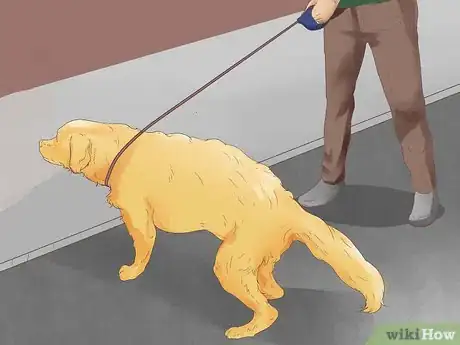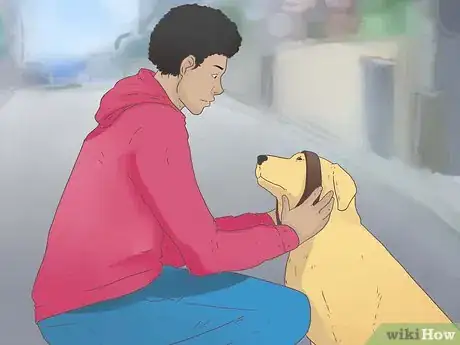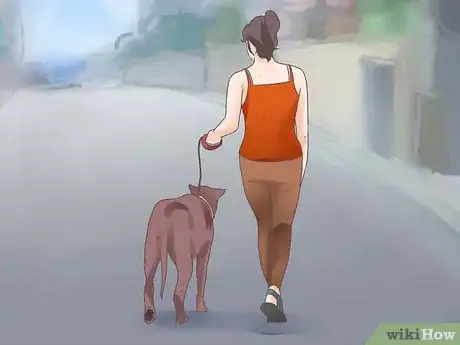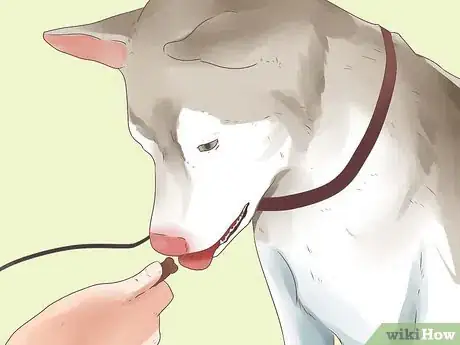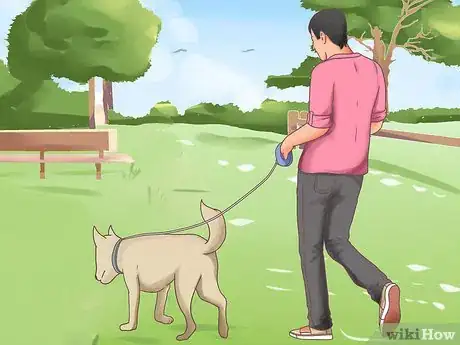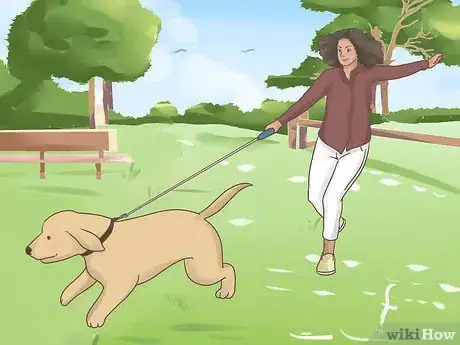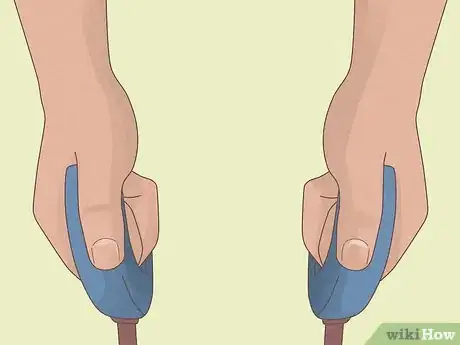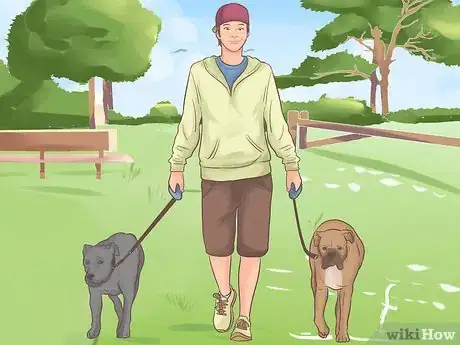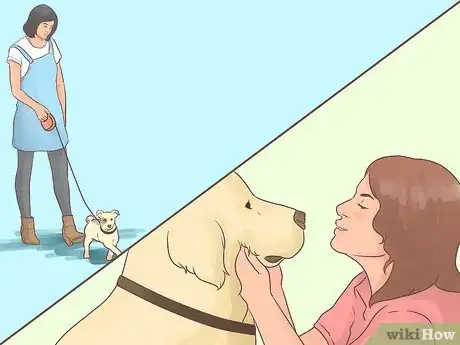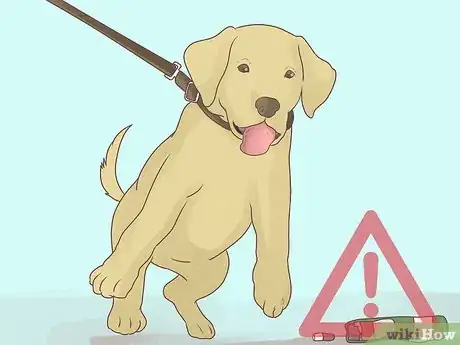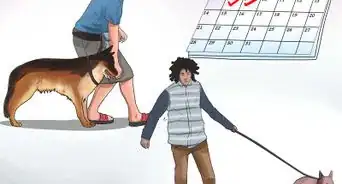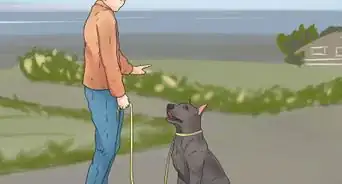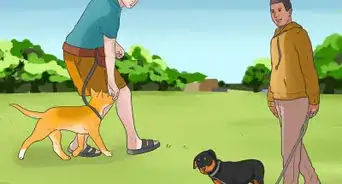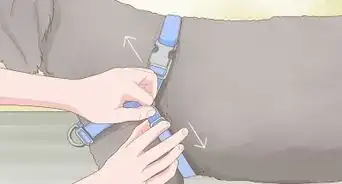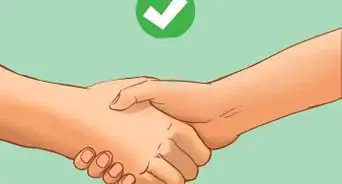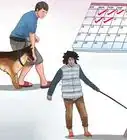This article was co-authored by David Levin. David Levin is the Owner of Citizen Hound, a professional dog walking business based in the San Francisco Bay Area. With over 9 years of professional dog walking and training experience, David's business has been voted the "Best Dog Walker SF" by Beast of the Bay for 2019, 2018, and 2017. Citizen Hound has also been ranked #1 Dog Walker by the SF Examiner and A-List in 2017, 2016, 2015. Citizen Hound prides themselves on their customer service, care, skill, and reputation.
This article has been viewed 32,301 times.
Walking one dog takes lots of care and dedication. Walking two dogs? That can be a challenge. If you want to learn to walk two dogs at the same time, you can learn what you'll need to pull it off correctly, and how to walk your dogs safely and efficiently.
Steps
Preparing for a Walk
-
1Use the proper kinds of leashes. If you're going to walk two dogs, choose solid leashes with a set length, about 1.5 meters or more. Any style is appropriate, but thick braided nylon leashes tend to be the strongest and longest lasting. Pick one appropriate to your dog's size and energy level.[1]
- Variable-length button-activated leashes tend to get tangled a lot more easily and encourage the dogs to pull at the leash. When the leash suddenly gives way as you give it more length, this gives the dog an incentive to yank at it.
-
2Get everything you'll need for the walk. Aside from the leashes, it's good to take a couple of bags (assume each dog will need two), and some readily available doggy treats if you're actively training the dogs. Keys, cell phone, and you're ready.
- If you're going for a very long walk, you may also want to bring a little water with you in a bottle. Dogs pant when they're very thirsty, and need to be provided clean drinking water on a regular basis.
Advertisement -
3Provide water before walks. Make sure the dogs have access to clean water at all times, and make sure they get a chance to drink up before you head out on a long walk. Dogs might not always be interested in drinking, so it's not necessary to force it, but just make sure they have a chance to drink if they're interested.
- Dogs often need to go out shortly after eating or drinking. These are good times to schedule walks into your routine.
-
4Practice walking the dogs separately at first. Leash training is a lot easier if you do it with one dog at a time. It's very difficult to try to leash-train more than one dog at a time. After they've gotten experience walking on the leash, it's fine to try walking them together.
Training Dogs on the Leash
-
1Lead the dog, don't let the dog lead you. You should be the first one to set foot outside of the house when you go for a walk, especially if you're going with more than one dog. Lead the way and provide your dogs with directions and not vice versa. If the dogs follow your "stay" command, call them out and make them sit while you lock up.
- Attach the leash to the collar before you leave the house. Spend a lot of time at the door getting your dog to calm down before you go outside, if there's a lot of excitement.
-
2Keep the dog close to your body. When you're first starting, try to keep the dog on a relatively short leash. Cinch the leash up on your wrist, so the dog will have to stay close at your side. You want to train the dog to stay that close to you at all times, even when the leash is a little bit longer. This makes the walk a lot smoother and more comfortable.[2]
-
3Control the movement of the walk. If one dog starts yanking at the leash in a particular direction, don't go in that direction. Stop moving, command the dog to heel, or sit, and wait until the dog relaxes and gets under control before you start walking again.
- Some trainers find it effective to "ask" the dog to stay close. As dog comes to you, reward him. You can even click down being next to you with a clicker.
- Don't tug hard on the leash, but stay consistent and demand proper behavior. If you start walking and dog still pulls after multiple attempts, stop for a while.
-
4Reward the dog for good behavior. When the dog walks calmly at your side, staying on the leash, give a little treat and praise. As your dog stops pulling, start enforcing "heel" or "side" commands, to get the dog to walk closely. Dog should stay at your left at all times. Practice short walks (2 steps at first) with release commands and luring with treats.[3]
-
5Let them explore some as they get well behaved. It's good to be in control of the walk, but the walk is for their benefit ultimately. Let them smell, stop, search, and explore like they want. Continue walking at a calm pace, but take a minute or two to stop as well.
- Any time you can let dogs off leash is a good time. Find a dog park in your area if you don't have any fenced land they can roam in.
-
6Be patient. It can take some dogs a long time to get trained properly on the leash. It's an unnatural and strange thing for the dog, and will only work with some careful training and some dedicated work.
- It's actually a lot easier to let the dog drag you around, but it'll result in a poorly trained dog that's difficult to walk on the leash. It takes some serious self control not to yank the dog back at you, or to just be dragged along for the ride.
- try to be cheerful, because it will make the walk go much smoother for the dog. As you change your walking direction, enhance good behavior with some doggy snacks and encouraging talk.
Walking With Your Dogs
-
1Hold one leash in each hand. Get your leash loop on your right hand and leash into your left hand with your dog on the left side. Put the hand through the hole and around the wrist a couple times, if the rope is big enough.
- Leave some slack in the leash, between you and the dog so even if he pulls it out of your hand its still on your wrist.
- Keep a tight grip on the leashes. Even calm and well-trained dogs can get distracted and start running without and you seeing them and pull the leash off the hand. And if you've got two, it's even more important to get a solid grip on things to keep them under control.
EXPERT TIPDavid Levin is the Owner of Citizen Hound, a professional dog walking business based in the San Francisco Bay Area. With over 9 years of professional dog walking and training experience, David's business has been voted the "Best Dog Walker SF" by Beast of the Bay for 2019, 2018, and 2017. Citizen Hound has also been ranked #1 Dog Walker by the SF Examiner and A-List in 2017, 2016, 2015. Citizen Hound prides themselves on their customer service, care, skill, and reputation.Professional Dog Walker
 David Levin
David Levin
Professional Dog WalkerTry using a leash splitter to leave one of your hands free. If you're walking 2 or more dogs at the same time, use a leash splitter or leash coupler. You can even make your own coupler by using a ring or a carabiner from a hardware store. That way, you can leave one hand free in case you need to deal with a dog that's struggling. It will also be easier to give the dogs nonverbal indicators if you have a free hand.
-
2Keep the dogs on different sides. The easiest way to keep the dogs separated is to keep them on separate sides of your body. Let dogs sniff at the opposite sides of sidewalks, and walk them with your body in between. This will keep the leashes from getting tangled.
- Dogs will often want to sniff at the same things. If the dog on your left tries to cross over to your right, practice turning with the dog, or keeping the dog moving forward by giving a short little yank on the leash to move forward.
- If your'e walking very small dogs, they can sometimes stay on the same leash, with leash-dividers. This is usually the best way to keep them under control. They'll usually stay out of the other's way.
-
3Make up for energy differences with play. If you try to walk a very big dog and a very small dog, or a very old dog and a very young dog, you can have different types of challenges. If one dog needs to meander and another dog needs to run, you've got to make up for that with a little bit of work.
- If you're going to walk different sized dogs, remember to walk slowly for the small one, and play more with larger dog before you head out at home to get their speed about the same.
- In some cases, it's just easier to walk dogs separately. Not all dogs make good combinations. Try to match their energy level and walking speed, if at all possible.
-
4Make sure the dogs don't get into anything. While it might seem silly, it's a lot more difficult to keep track of two dogs at the same time. You're picking up one's mess and the other's got a mouthful of chicken bone from the sidewalk. try to stay diligent.
- Keep an eye out for debris on the sidewalk. Look for shattered glass or cigarette butts on the ground. Don't let them eat anything they're trying to get at.
- Choose the place you're walking them carefully and go there without them before go for the walk. Make sure the sidewalk is big enough and traffic is quiet.
-
5Slow down. Often, when you're walking two dogs, they'll start getting excited and go into pack mentality. This means there will be a competition between them. try to stay calm to counterbalance their excitement. Don't let them start going faster or slower, but try to maintain a calm rhythm. Stop and pet them regularly if they're getting too worked up.[4]
References
About This Article
Before walking 2 dogs, select 2 sturdy leashes that are at least 1.5 meters long. You can also prepare by gathering other supplies, like clean-up bags, treats, and water. To make your walks as smooth as possible, leash train both dogs separately before you walk them together. If one dog is more energetic than the other, play with the livelier pup to tire it out a little before the walk so that the slower dog doesn’t have to rush to keep up. When you’re ready to walk, hold each leash in a separate hand and keep the dogs on either side of you. As you walk, keep an eye on both dogs and make sure they don’t get into things or get over-excited. In case they do get wound up, you can always slow down or take a break. To learn to leash train your dogs, read on!
